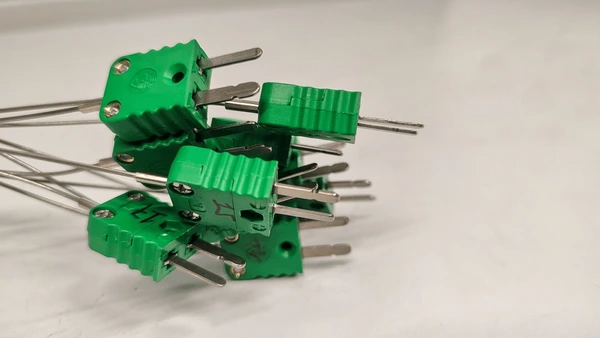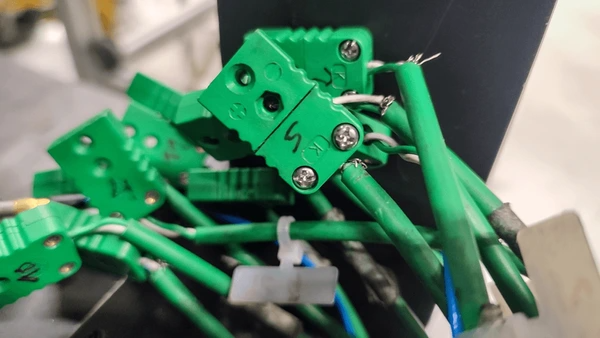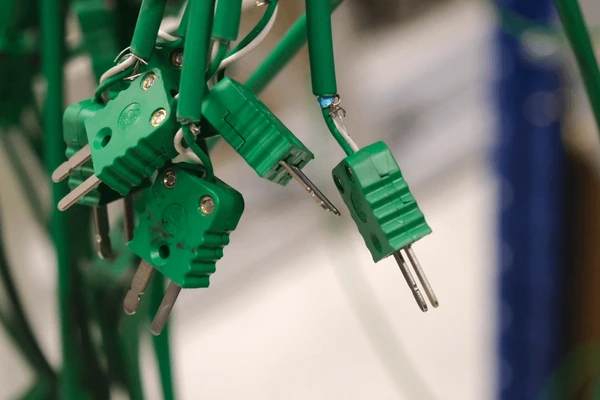
What Is a K-Type Thermocouple?
A K-type thermocouple is a widely used temperature sensor that operates based on the Seebeck effect, which is the principle of generating a voltage potential when two dissimilar metals are joined together and subjected to a temperature difference. It consists of a positive wire (Chromel, an alloy of nickel and chromium) and a negative wire (Alumel, an alloy of nickel, aluminum, and silicon).

How a K-Type Thermocouple Works
When two wires are joined at one end (the hot junction) and experience a temperature difference from the other end (the cold junction), they generate a thermoelectric voltage, or EMF. This voltage is directly proportional to the temperature difference between the hot and cold junctions. The EMF is measured using a voltmeter or data acquisition system for temperature assessment.
Key Features of K-Type Thermocouples
K-type thermocouples are known for their:
- Wide temperature range: -200°C to 1300°C
- Good linearity and sensitivity
- Relatively large thermoelectric voltage
- Excellent oxidation resistance and durability
- Low cost and ease of use
However, they can exhibit non-linear behavior and drift due to factors like short-range ordering, oxidation, and cold-work effects, especially at higher temperatures.
Advantages of K-Type Thermocouples
- Wide temperature range: K-type thermocouples can measure temperatures from -200°C to +1350°C, making them suitable for a broad range of applications.
- Low cost: K-type thermocouples are relatively inexpensive compared to other thermocouple types, making them economical for industrial and commercial applications.
- Durability: K-type thermocouples are robust and can withstand harsh environments, making them suitable for various industrial processes.
- Versatility: K-type thermocouples can be used in various industries, including automotive, aerospace, chemical processing, and power generation.

Challenges of K-Type Thermocouples
- Limited accuracy: K-type thermocouples have lower accuracy compared to other thermocouple types, especially at higher temperatures.
- Susceptibility to oxidation: The positive leg (chromel) of K-type thermocouples is susceptible to oxidation at high temperatures, which can affect its accuracy and lifespan.
- Non-linearity: The voltage-temperature relationship of K-type thermocouples is non-linear, requiring compensation or linearization techniques for accurate measurements.
- Limited high-temperature performance: While K-type thermocouples have a wide temperature range, their accuracy and stability can degrade at temperatures above 1000°C.
Applications of K-Type Thermocouple
Temperature Measurement in Industrial Applications
K-type thermocouples are widely used for temperature measurement in various industrial applications due to their low cost, wide temperature range (0°C to 1300°C), and durability. They are commonly employed to measure the temperature of liquids, gases, and solid surfaces in manufacturing processes.
High-Temperature and Transient Temperature Measurement
K-type thermocouples are suitable for measuring high temperatures and transient temperature changes, such as in missile explosion fields and blast furnaces. Their fast response time and ability to withstand harsh environments make them ideal for capturing rapid temperature fluctuations.
Precision Temperature Measurement
With proper signal conditioning, cold junction compensation, and piecewise fitting techniques, K-type thermocouples can achieve high-precision temperature measurement with an accuracy of ±0.1°C in the range of -50°C to 500°C. This level of precision is crucial in applications requiring tight temperature control.
Error Analysis and Uncertainty Evaluation
Understanding and analyzing the sources of measurement errors and uncertainties associated with K-type thermocouples is essential for improving accuracy and avoiding production losses. Factors such as residual cold-work, ordering effects, oxidation, and manufacturing variations can contribute to drift, hysteresis, and measurement uncertainties.
Dynamic Calibration and Compensation
To account for the dynamic characteristics of K-type thermocouples, dynamic calibration systems and compensation techniques have been developed. These involve using semiconductor lasers, infrared detectors, and calibrated thermocouples to obtain the time constant and model dynamic compensation filters, improving the accuracy of transient temperature measurements.

Latest Technical Innovations in K-Type Thermocouple
Thermocouple Circuit Design
- Transient high-temperature conditioning circuits based on K-type thermocouples have been developed for applications like missile explosion field testing. These circuits use instrumentation amplifiers, analog switches, and active filters to control and filter the thermocouple output signal.
- High-precision temperature measurement devices using K-type thermocouples employ techniques like cold junction compensation, piecewise fitting, and dedicated analog-to-digital converters to improve measurement accuracy to ±0.1°C over a wide range.
Error Analysis and Uncertainty Reduction
- Detailed error analysis and uncertainty evaluation of K-type thermocouples is crucial to avoid measurement errors and production losses. Key sources of error include non-linearity, cold junction effects, and manufacturing variations.
- Studies have investigated the effects of cold work, ordering, and oxidation on the drift and hysteresis characteristics of K-type thermocouples from different manufacturers, showing significant variations in measurement uncertainties.
Cold Junction Compensation
- Accurate cold junction compensation is essential for K-type thermocouple measurements. Techniques like using the algebraic sum of environmental potentials and spot potentials as the standard potential have been developed for improved compensation accuracy.
High-Temperature Performance
- Innovations in thermocouple design, such as using protective metal sheaths and temperature-resistant coatings, can enable conventional K-type thermocouples to operate at higher temperatures, up to 1900°C or higher, while preventing drift and oxidation.
- New negative electrode alloy compositions for K-type thermocouples, containing elements like cobalt, manganese, aluminum, iron, yttrium, niobium, vanadium, and carbon, have been developed to improve temperature measurement accuracy at high temperatures (0-1200°C).
Manufacturing Techniques
- Laser microwelding techniques, using high-power diode lasers or Nd:YAG lasers, have been explored for joining K-type thermocouple wires. These methods can produce beadless, porosity-free butt joints with improved response times and tensile strengths compared to conventional arc welding.
FAQs
- What is the temperature range of a K-Type Thermocouple?
It typically operates between -200°C to +1,260°C (-328°F to +2,300°F), depending on the sheath material. - How accurate is a K-Type Thermocouple?
The accuracy is usually within ±1.5°C or ±0.4% of the measured temperature. - What are the common uses of K-Type Thermocouples?
They are used in industrial processes, scientific research, automotive testing, and HVAC systems. - How do you calibrate a K-Type Thermocouple?
Calibration involves comparing the thermocouple’s readings to a known temperature source and adjusting the system accordingly. - Can K-Type Thermocouples be used in corrosive environments?
Yes, but a protective sheath may be required to prevent damage in highly corrosive conditions.
To get detailed scientific explanations of k-type thermocouples, try Patsnap Eureka.

Learn more
Multiplexor: Efficient Data Selector for Electronics
Understanding STP Cable: Shielded Twisted Pair Explained
Understanding Twisted Pair Cable: Basics, Benefits, and Uses
JFET 101: A Beginner’s Guide to Junction Field-Effect Transistors
HDMI vs. DisplayPort: Which is Best for Your Monitor?
